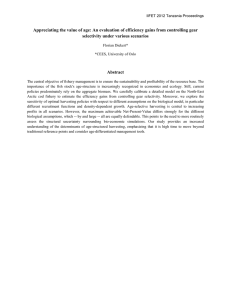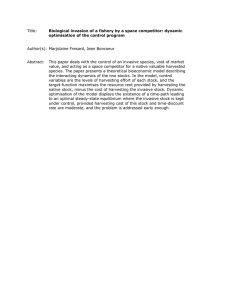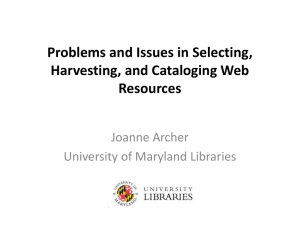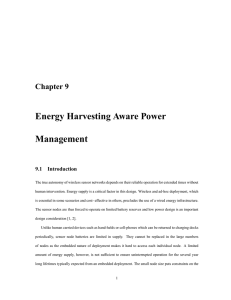Design and Power Management of Energy Harvesting Embedded
advertisement
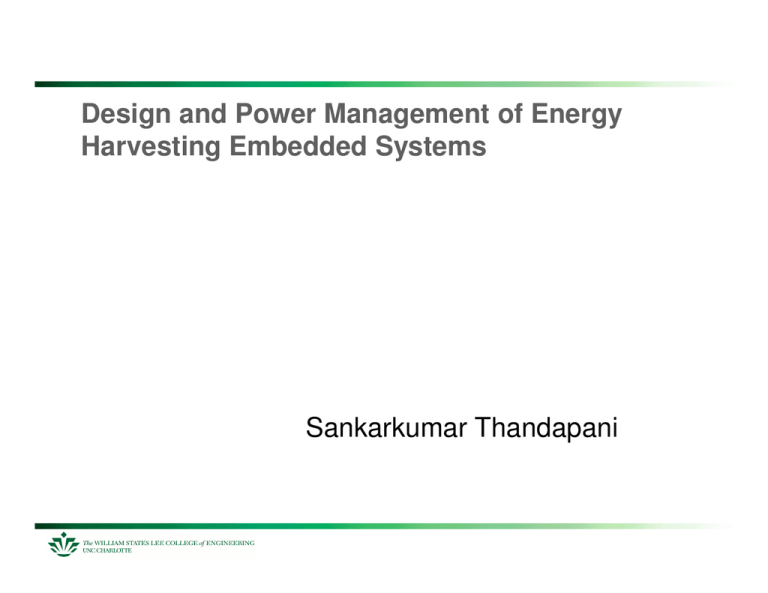
Design and Power Management of Energy Harvesting Embedded Systems Sankarkumar Thandapani The Contents • Introduction about energy harvesting devices • System design issues • Power management related issues 2 Energy Harvesting System - WSN • Harvester • Storage Device • Sensor Node 3 System Design Issues 1. Voltage and Current • • • • • Without high enough voltage, it is difficult or impossible to either power the system directly or to charge an energy storage device Voltage regulators are used to bridge the gap between the supply and the consumer. Linear and switching regulators Switching regulators – Buck, Boost and Buck-Boost Power efficiency and energy efficiency are different 4 System Design Issues 2. Maximum Power Point Tracking( MPPT) • • • • • Occurs when supply and load are impedance matched The input intensity can be determined by measurement either before or after conversion to electricity. The control for MPPT can be implemented either in hardware or software Hardware control – simple, low overhead but tend to track MPP with a hysteresis band Software control – Use precious I/O pins and overhead is more due to use of DSP 5 System Design Issues 3. Power deframentation • One problem with harvesting energy from environmental sources is the wide dynamic range of power. • Even with MPPT, the available power may be so low that it is below the useful threshold. • To solve this problem, one may wish to harvest energy from multiple sources. 6 System Design Issues 4. Energy Storage devices • Rechargeable Battery – low leakage but limited charge cycles • Supercapacitors – infinite charge cycle but more leakage but it is less of a problem if energy is replenished frequently • Hybrid • The combination of MPPT using supercapacitors poses new challenges 7 Power Management Issues 1. Energy Neutrality in Harvesting Systems • • • • Conventional energy optimization metrics might not be suitable in an energy harvesting scenario. The objective in a battery-powered sensor networks is to maximize network lifetime under a total energy constraint. This changes if energy harvesting is allowed since the amount of energy available itself depends on the time duration for which the system operates. A more relevant design objective might be to operate in an energy neutral mode, consuming only as much energy as harvested. 8 Power Management Issues 1. Energy Neutrality (continued) • Theorem - Model of the power generated by the harvester: ρT – σ2 ≤ t+T∫t P(t)dt ≤ ρT+ σ1 Ps(t) – Power output ρ – rate at which energy is available from the transducer σ1, σ2 – the burstiness caused by temporal variations is bounded by σ1 and σ2. 9 Power Management Issues 2. Node Level Power Management • Power management at runtime • An algorithm for harvesting-aware duty cycling of wireless sensor nodes. • Dynamic voltage scaling. • Determining the optimal duty cycle for a node using Exponentially Weighted Moving-Average (EWMA) filter based prediction model. 10 Power Management Issue 3. Network Level Power Management • Power management considering the whole network. • Energy aware routing protocols in sensor networks typically use battery energy based routing cost metrics. • But only battery awareness is not sufficient to select the best routes. • Hence an enhanced routing cost metric that considers both the harvesting potential of a node as well as its residual battery level is needed. 11 So, what is the conclusion ? • Active research on Energy Harvesting Devices • Energy harvesting embedded systems have a brand new class of applications • The power consumption has been reduced to the same level as the harvesting devices are capable of outputting. • But, it seems unlikely that existing systems can automatically operate efficiently by just adding an energy harvesting module. • In order to operate efficiently the entire system must be optimized in a holistic way from the design of the architecture to power management at the application and networking levels. 12 Questions and comments 13


